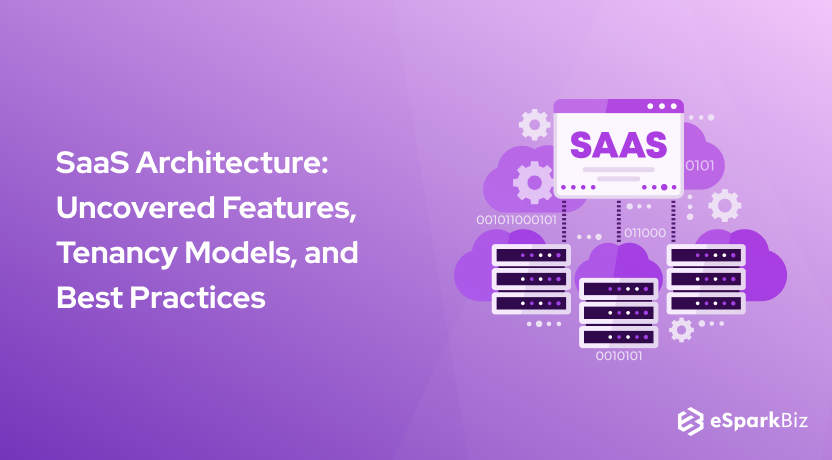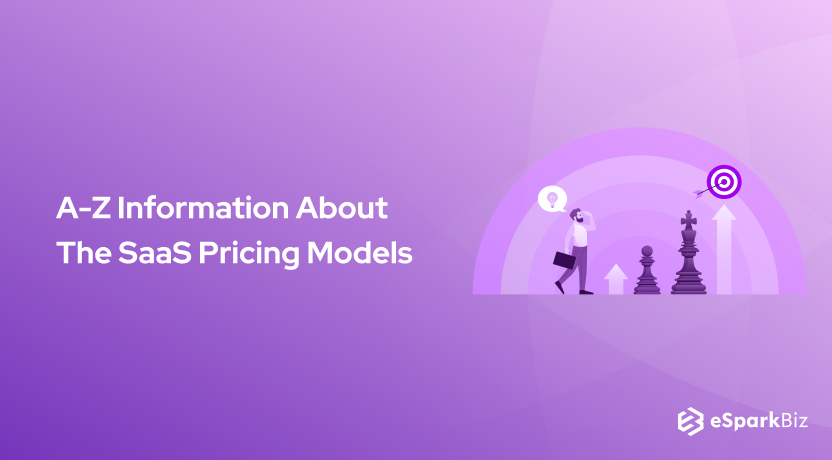Are you looking for ways to optimize technology costs and develop innovative products? Did you decide to go with SaaS? Well, it is indeed an ideal decision!
The adoption of SaaS has been rising among organizations in recent times. The SaaS market is likely to reach USD 258.60 billion by the end of 2024. Moreover, it is expected to reach USD 374.50 billion by 2028.

SaaS allows organizations to shift their applications to the cloud and avail of subscription-based services. It eliminates the need for any on-premise installations and proves to be an excellent solution for businesses of all sizes.
In the modern competitive era, scalability, flexibility, and easy customization have become crucial for every organization. SaaS architecture helps meet these demands in the best possible way. It enables businesses to meet the requirements of customers holistically.
Before we get into further details, it is important to have a basic idea of what SaaS is. So, let’s read on.
What is SaaS?
Before we get into further details, it is important to have a basic idea of what SaaS is . Saas, or Software-as-a-service refers to a web-based software application that is delivered to end-users over the Internet.
You no longer have to install or maintain software on any device, as SaaS provides a subscription-based model and allows users to access the software and its infrastructure easily. SaaS providers are responsible for maintaining the database layers, code base, and application servers that make up the entire application.
The flexibility of the model makes it a top choice among organizations around the globe. On average, there are about 80 SaaS applications in use globally, and nearly 21 are custom SaaS applications.

SaaS helps eliminate the need to maintain the software and lowers the additional burden. It enables organizations to maintain a perfect balance between productivity and security. Moreover, as flexible workplaces continue to be the norm, cloud solutions enhance the accessibility of data for employees.
Prominent Components of SaaS
Have you ever wondered how to differentiate one application from another? Well, that is where the key components come into the picture. Some of the core components of a SaaS application are listed below.
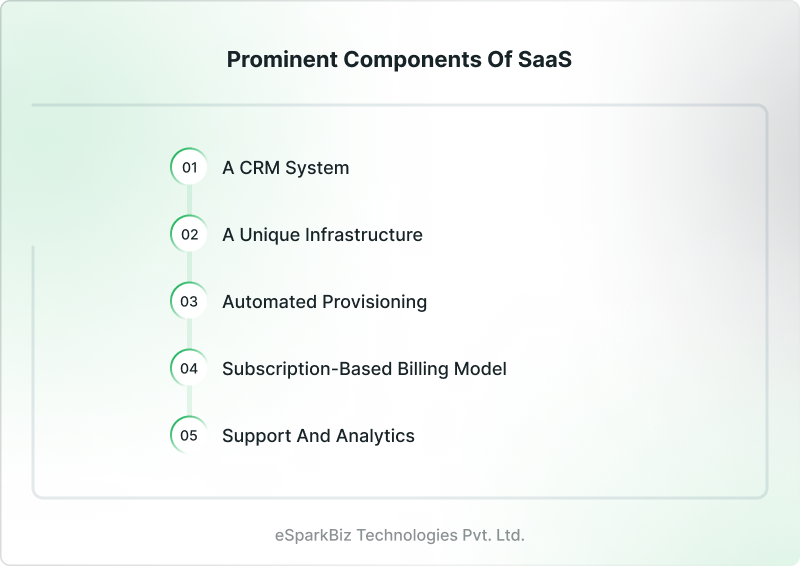
A CRM System
When it comes to differentiating one application from another based on its components, customer relationship management (CRM) systems top the list. SaaS provides a common platform that is accessible to multiple tenants.
Therefore, there is a need for a single repository for several customer accounts. It helps in the management of the account details of different customers.
A Unique Infrastructure
SaaS offers a unique data infrastructure for every organization. The good news is that the SaaS infrastructure can be easily customized to meet the requirements of businesses.
It provides you with the flexibility to select the components that your business requires and pay for them only. Once the payment period is over, the users will return to the previous model.
Commonly, SaaS users buy the software on a billing system that functions on a yearly or monthly basis. It can easily scale up or down based on customer and business demand. That’s how Saas boasts a flexible infrastructure for all types of long-term or short-term business needs.
Automated Provisioning
Automated provisioning of SaaS applications allows convenient onboarding of customers. By pushing essential framework-related updates to subscribers, Saas improves the operational efficiency of independent software vendors or ISVs. Moreover, it helps eliminate the burden of managing the release schedules of upgrades, patches, and deployments.
Subscription-based Billing Model
The availability of software as a service is at the core of SaaS applications. This service is provided to users on a flexible billing cycle. It enables business clients and users to take complete control of what they want and how much they want.
Support and Analytics
The customer support and analytics of the SaaS applications provide a comprehensive toolkit to check metrics and manage the platform. It enables the SaaS providers to meet the expectations of their clients. Moreover, it makes it easier for businesses to enhance customer experiences and meet the demands of the market.
Now let’s look at some of the software architecture that Saas offers for your various needs.
Common Architecture Types for SaaS Applications
SaaS applications have become more popular in recent times. The pandemic imposed several physical restrictions on the organizations. However, the SaaS applications made it possible for businesses to work remotely.
During the pandemic, there was an increase in SaaS expenditure of nearly 10 to 20 percent. That shows the ability of SaaS to support digital transformation.
Now you must be wondering what makes the SaaS applications so different. Well, it is the SaaS platform architecture. SaaS architecture can be divided into various categories based on the software category, industry, and tenancy model.
However, tapping into the potential of SaaS can be difficult if you do not have a sufficient idea about the SaaS platform architecture. That is why knowing about the different architectures matters a lot.
Let’s explore them in detail!
Broad Categories: Based on Functionality Coverage and Industry
Horizontal SaaS
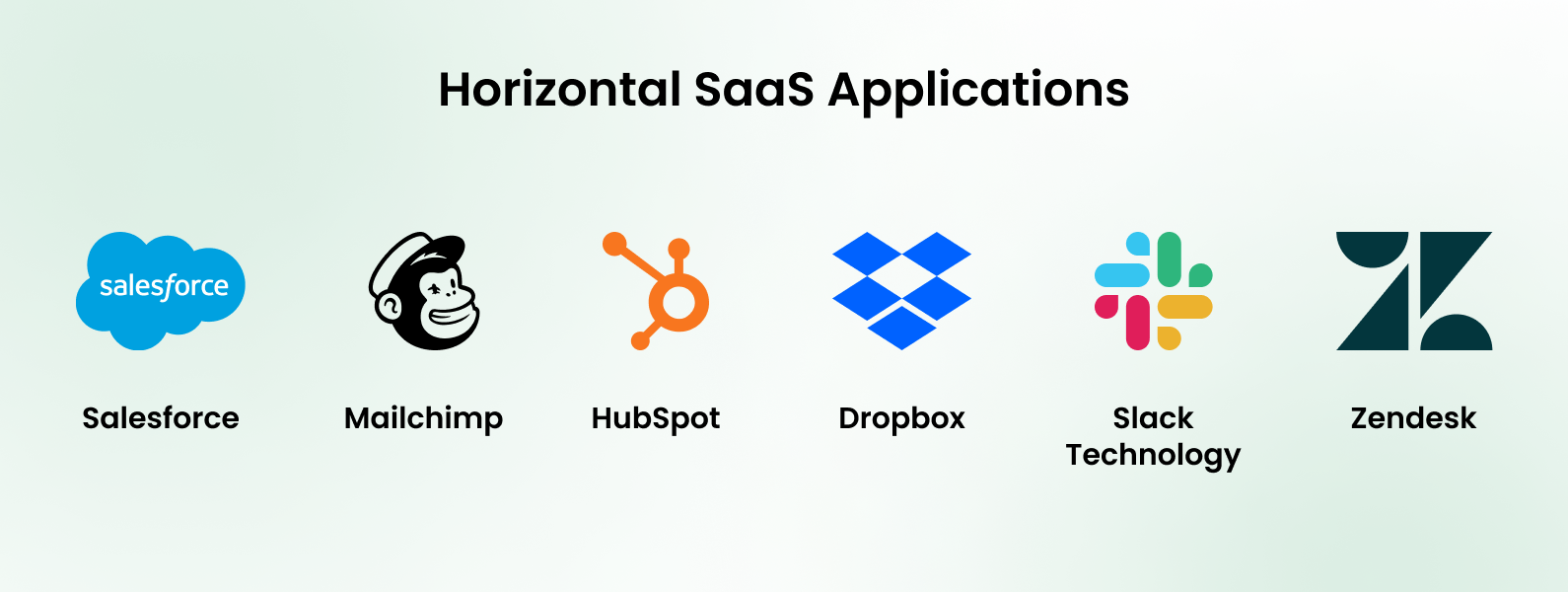
Horizontal SaaS applications place a major focus on functionality instead of industry requirements. This SaaS architecture emphasizes the software category, irrespective of the industry of the client.
For instance, sales, marketing, and communication find use across all industries. A SaaS application providing these functionalities can easily meet all the business requirements.
However, a point to note here is that this SaaS architecture type offers a single service or functionality. So, organizations need to determine what matters to them the most and accordingly select the right app. That means organizations will have to invest in several SaaS applications to meet their unique demands.
Some of the prominent examples of horizontal SaaS applications are Slack Technologies, Salesforce, Zendesk, HubSpot, Dropbox, and Mailchimp.
Vertical SaaS
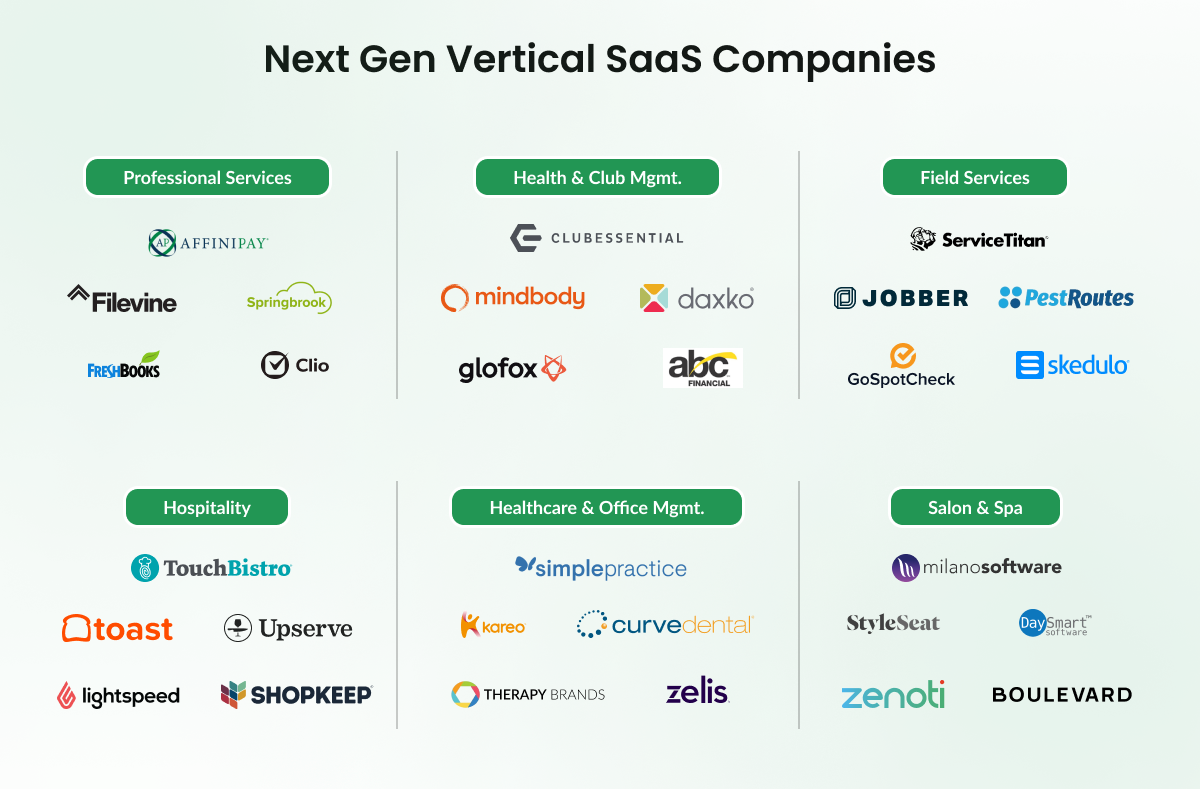
The next type of SaaS infrastructure architecture, based on industry and functionality coverage, is vertical SaaS. It is an architecture that is designed for specific industry verticals only. It includes real estate, healthcare, finance, retail, logistics, agriculture, and many more.
Vertical SaaS has been experiencing significant growth over the years. At times, it may appear to be a narrower approach to developing SaaS applications. However, it can serve the broader needs of industries.
Vertical SaaS provides various services and functionalities for a single industry.
Thus, proving to be highly beneficial for its organizations. However, you need to take into consideration your unique requirements, market demands, and budget.
Tenancy Models of SaaS: Based on Component Shareability
The tenants are the fundamental components of the SaaS applications. The tenancy models are based on the tenants.
Are you wondering who the tenants are? Well, every customer who makes use of a SaaS platform is known as a tenant. The tenants get access right away through the payment of a subscription fee.
A point to note here is that the choice of tenancy model will not affect the performance of your application. Instead, it allows you to meet specific consumer demands. Moreover, it also offers flexible solutions for developers and makes it easier to maintain operational complexities and set costs.
Also Read – How Much Does It Cost to Build SaaS Application?
Single Tenant Architecture
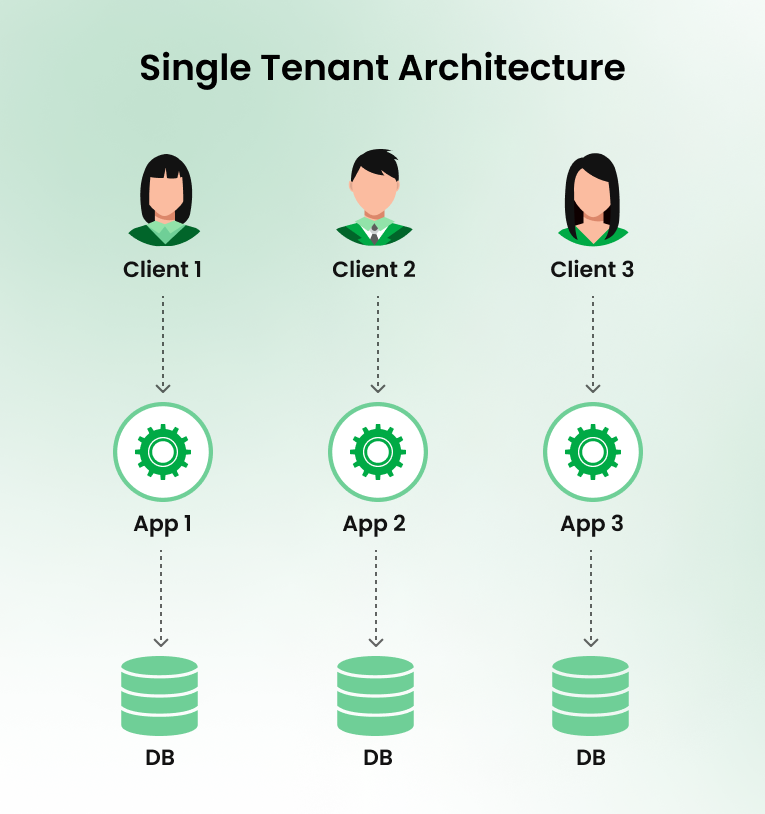
When it comes to the different types of SaaS platform architecture, the single-tenant architecture is a prominent one. As the name suggests, this architecture serves only one customer, who pays for the software service. When you choose this architecture, you get dedicated software, including a single infrastructure, database, and architecture.
The single-tenant SaaS architecture proves to be beneficial for individual organizations. It is because they do not have to share the resources with any other customer.
Moreover, it lets the buyer customize the software application based on their unique business needs. Also, scaling up and down the software is simple and easy.
One of the examples of single-tenant architecture is Oracle Cloud. It makes use of this architecture to deliver a private cloud SaaS environment. The architecture has separate compartments with granular access control and isolated resources.
It enables customers to have different versions of the same product. Also, it grants access to app customization as per the specific requirements of the business.
Multi-Tenant Architecture
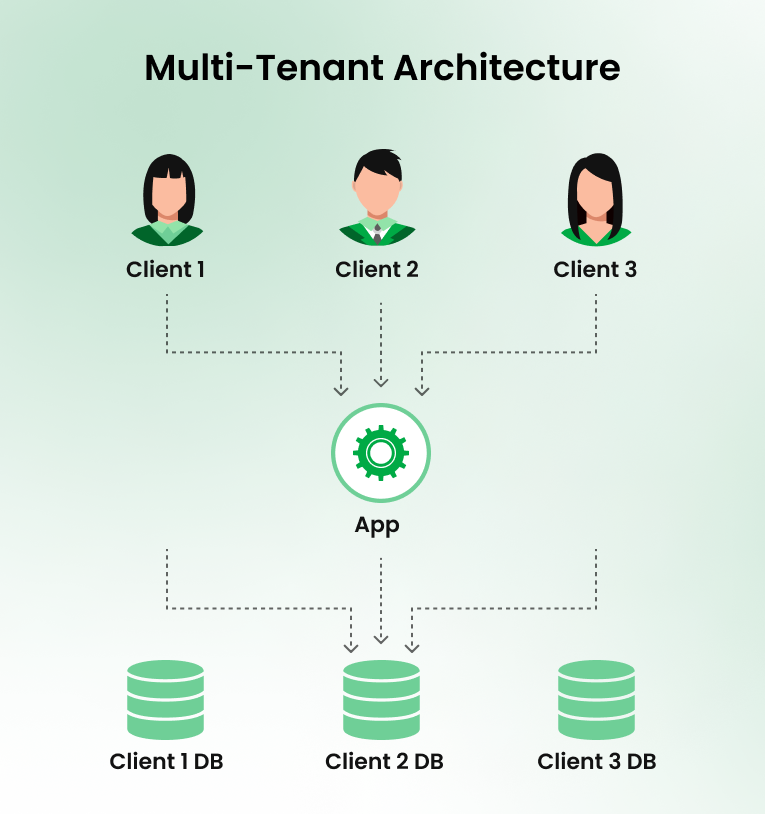
Another common SaaS application architecture is the multi-tenant architecture. It is among the highly preferred architecture types. Every single instance of this model serves more than one tenant. All the tenants have access to the same application information and common database.
However, the data of every tenant is secured. One of the best examples of multi-tenant SaaS architecture is Google Workspace or G-Suite. Many tenants share a single application through the internet. The common database of Google Cloud is shared by the tenants, and they get access to 15 GB of free data.
You do not have to worry about the security of your personal information, even though all the resources are shared by multiple tenants. It is because they are stored separately to ensure the highest level of security and safety.
Mixed Tenant Architecture
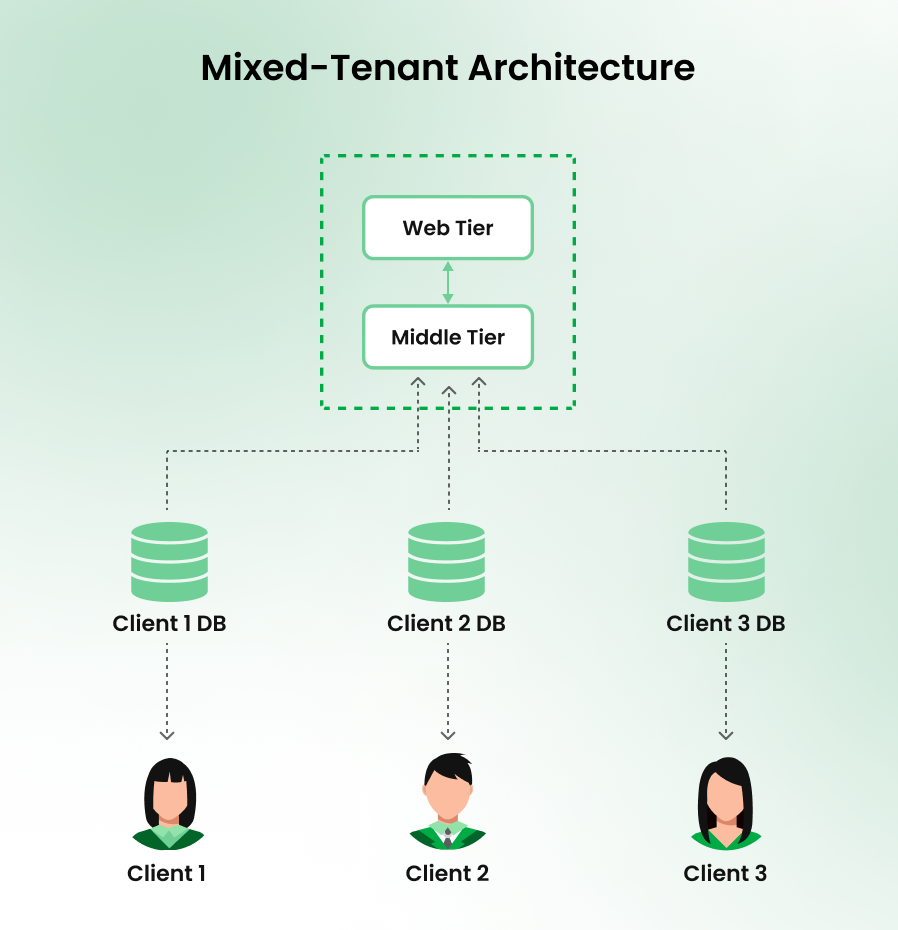
Another SaaS architecture design is mixed-tenant architecture. In the case of single-tenant and multi-tenant architectures, the functionalities and boundaries are already laid out. However, that is not the case in mixed-tenant architecture.
Imagine a situation where a tenant utilizes different resources from a shared infrastructure. However, there may be certain business requirements that compel them to have only one or two dedicated components. That is where the mixed-tenant architecture comes into the picture.
In this model, one or two components of the application are dedicated to each tenant. On the other hand, the remaining components are shared among the tenants.
Also Read – A-Z Information About The SaaS Pricing Models
Different Models of Tenant Architecture
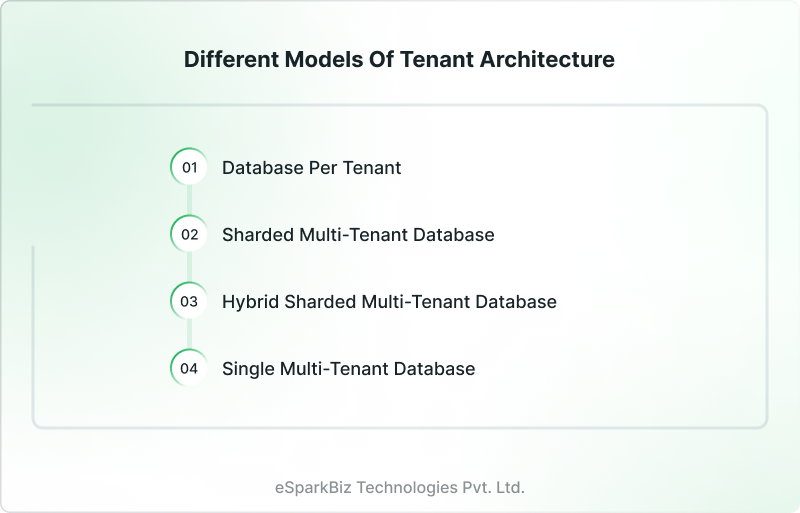
When it comes to software as a service, multi-tenant architecture is the most prominent choice. It is gaining more popularity among organizations owing to the following reasons:
- A tenant architecture is consistent and easy to maintain.
- It is a cost-effective architecture that provides more flexibility for better customization.
- This architecture offers a convenient resource utilization solution.
- It provides an excellent onboarding experience for new customers.
Are you planning to opt for the multi-tenant SaaS architecture? In that case, knowing about its different delivery models is vital. The four delivery models are outlined below.
Database Per Tenant
When it comes to databases, you might think that choosing a single-tenant architecture would be a better option. However, do not jump to a conclusion so soon.
In the database-per-tenant delivery model, you do get your own database. However, the database present in the same resource groups is divided into flexible pools. That means the SaaS vendors can move the databases within these pools to ensure resource optimization and better allocation.
Moreover, this model provides the vendors with the ability to scale their app tiers horizontally or vertically.
Sharded Multi-tenant Database
Sharding a database is a common practice. It helps enhance the performance and operational efficiency of the applications. When the workload increases on the multi-tenant database, sharding divides the tenant data and stores it across multiple databases.
The same shared database can also be moved to flexible pools. It improves the scalability and operational management of the applications.
Hybrid Sharded Multi-tenant Database
A hybrid sharded multi-tenant database refers to a model that offers vendors the flexibility to move tenants into sharded or dedicated databases. However, this model ensures that all the tenants get access to the necessary resources.
For instance, vendors can offer free trials with limited access to resources. On the other hand, premium subscribers can gain complete access to the application. That is when the hybrid multi-tenant model comes in handy.
Single Multi-tenant Database
This model has a lot of similarities to the multi-tenant architecture. However, it comes with multiple tenant identifier columns within the database. Therefore, besides the database, the compute and storage resources are shared among all the users.
When you opt for this model, the cost per tenant reduces. However, it can have an impact on the service’s performance. For instance, if one tenant consumes a lot of computing and storage resources, it can affect the performance of other tenants.
Key Principles of SaaS Architecture
By now, you must have an idea about the different types of SaaS architecture. Some of the principles of SaaS architecture design that you must know are listed below.
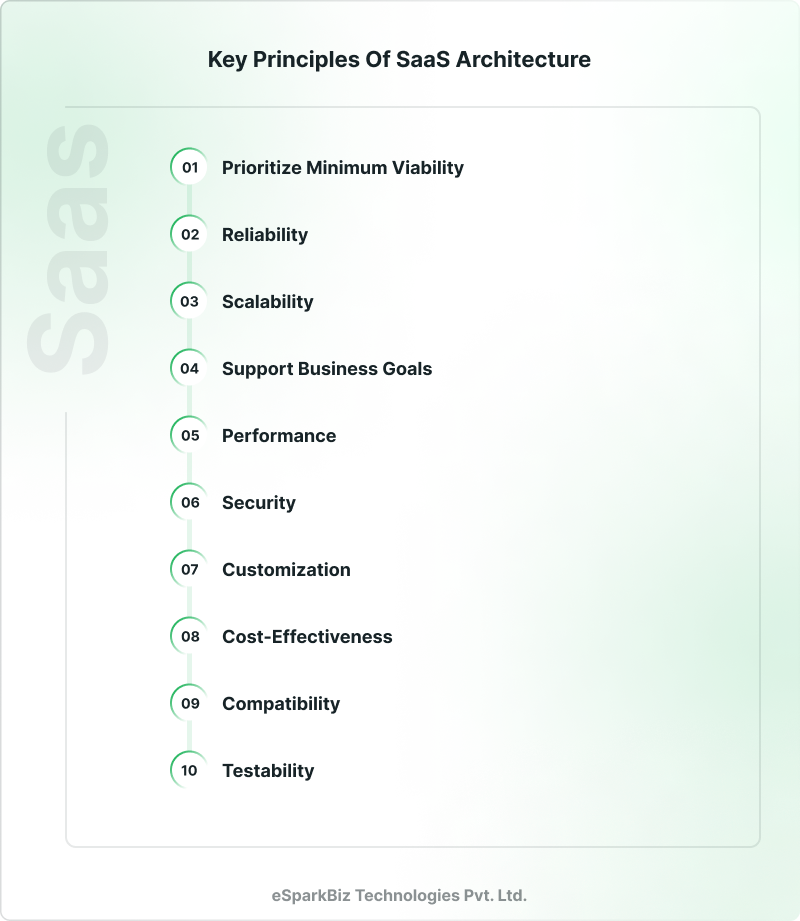
Prioritize Minimum Viability
SaaS should place a major emphasis on the minimum viable product. That means the architecture needs to be designed to efficiently deliver the core functionalities and features. Moreover, it must also offer the ability to add essential features in the future.
It helps lower the complexity of the architecture. Also, it can lower the cost of development, deployment, and maintenance. It even allows businesses to launch their products faster on the market and gain a competitive edge.
Also Read – All You Need to Know about SaaS Product development
Reliability
Reliability is the ability of the system to deliver consistent performance in terms of availability, speed, and quality. The SaaS architecture design must focus on ensuring availability and reliability around the clock. In other words, the architecture must be designed in a manner that lowers downtime and allows all-time access to the application for users.
Scalability
Scalability is yet another crucial principle of SaaS architecture. That means it should be able to support more data and users over time. It must be capable of effectively handling the growing number of users without affecting the performance of the application in any manner.
Moreover, the architecture must automatically add resources to store more data or handle more resources with minimal human intervention.
Support Business Goals
SaaS architecture must be able to support the unique goals and objectives of the business. In other words, the architecture must be capable of meeting the unique requirements of the customers.
As a matter of fact, the ultimate goal of every business is to derive value by meeting the needs of the customers. Therefore, it must be tailored to meet the requirements of the end users.
Performance
SaaS architecture should perform optimally to deliver a good user experience. Here, performance refers to the efficiency and speed of the system to deliver results. The application must function efficiently and provide a responsive user experience.
Security
Security ensures optimum protection of the systems from potential data loss and unauthorized access. The SaaS architecture must be designed by leveraging the appropriate security measures. It can protect the sensitive data of users from unauthorized access, disruption, destruction, or modification.
Customization
The main focus of the SaaS model is to lower the burden on organizations to manage their architecture. However, there is no one-size-fits-all SaaS architecture. So, the SaaS architecture must be able to enable users to customize the applications as per their unique requirements.
Cost-Effectiveness
SaaS infrastructure architecture needs to be cost-effective in comparison to PaaS and IaaS offerings. It should be efficient in terms of associated costs and resource usage. As a result, it can help organizations save more in the long run.
Compatibility
It is vital to ensure that the SaaS application architecture is compatible with different devices, users, and system configurations. Moreover, it should properly function with all devices and users, irrespective of the environment.
Also, the SaaS platform architecture must enable users to easily integrate essential solutions through third-party integrations.
Testability
The testability principle ensures that there is a perfect balance of testing and quality assurance for all individual users and tenants. It must allow the organizations to perform different tests to ensure that the system is error-free and efficient.
Why Opt for SaaS Architecture?
The popularity of SaaS continues to grow and is likely to remain so in the coming years. If you are still wondering why to choose the SaaS application architecture for your organization, then read on to explore the most convincing reasons.
Customer Benefits of SaaS:
- A subscription and elastic billing policy.
- Provides reliable and efficient digital services through the internet.
- Allows customers to disable or activate services as per their convenience.
- Offers a greater degree of flexibility for maintenance and customization.
- Cost-effective services in comparison to traditional software licenses.
Business Benefits of SaaS:
- Eliminates testing and maintenance costs.
- Provides scalable solutions to global customers.
- Lowers the time to market and offers a competitive edge.
- Allows vendors to push updates quickly.
- The public cloud lowers the infrastructure and maintenance costs.
Selecting the Right SaaS Architecture Model
If you have decided to opt for the SaaS architecture, the next step is to select the right one. To make the best choice, consider asking yourself the following questions:
- Is there a need for cloud services for your customers?
- For shared services, will the customers pay?
- Are your customers in search of isolated databases and applications in SaaS?
- Will all the customers be able to share a common application and database?
Finding answers to all these questions will enable you to easily decide between the available SaaS platform architecture models.
Conclusion
Every organization aspires to achieve maximum business goals. Choosing the SaaS architecture can make it simple and easy for them. By now, you must have a complete idea about the SaaS application architecture.
It offers greater flexibility to the users and proves to be a cost-effective solution for enhanced performance. From vertical SaaS architecture to multi-tenant architecture, various options are available. All you need to do is determine the exact needs of your business and make the apt choice.
With the right SaaS architecture design, delivering top-notch user experiences and delighting them to the core becomes easy. Collaborate with eSparkBiz a leading SaaS Development company that has experts and help you select the best SaaS architecture for your organization.

